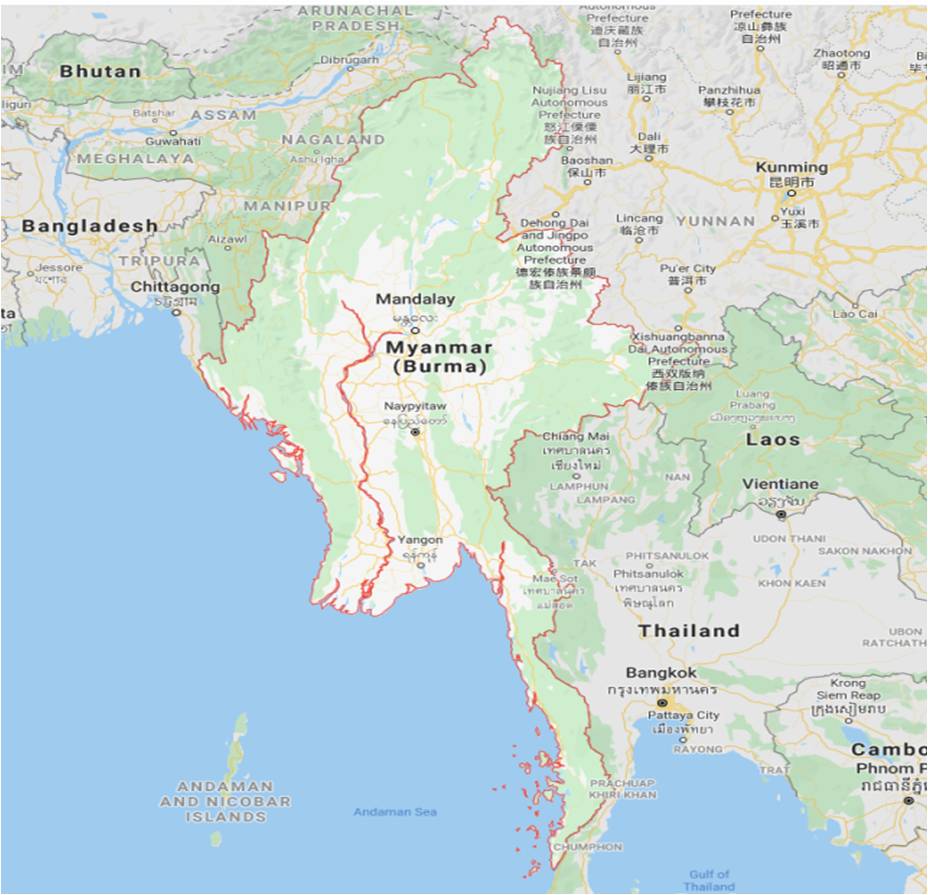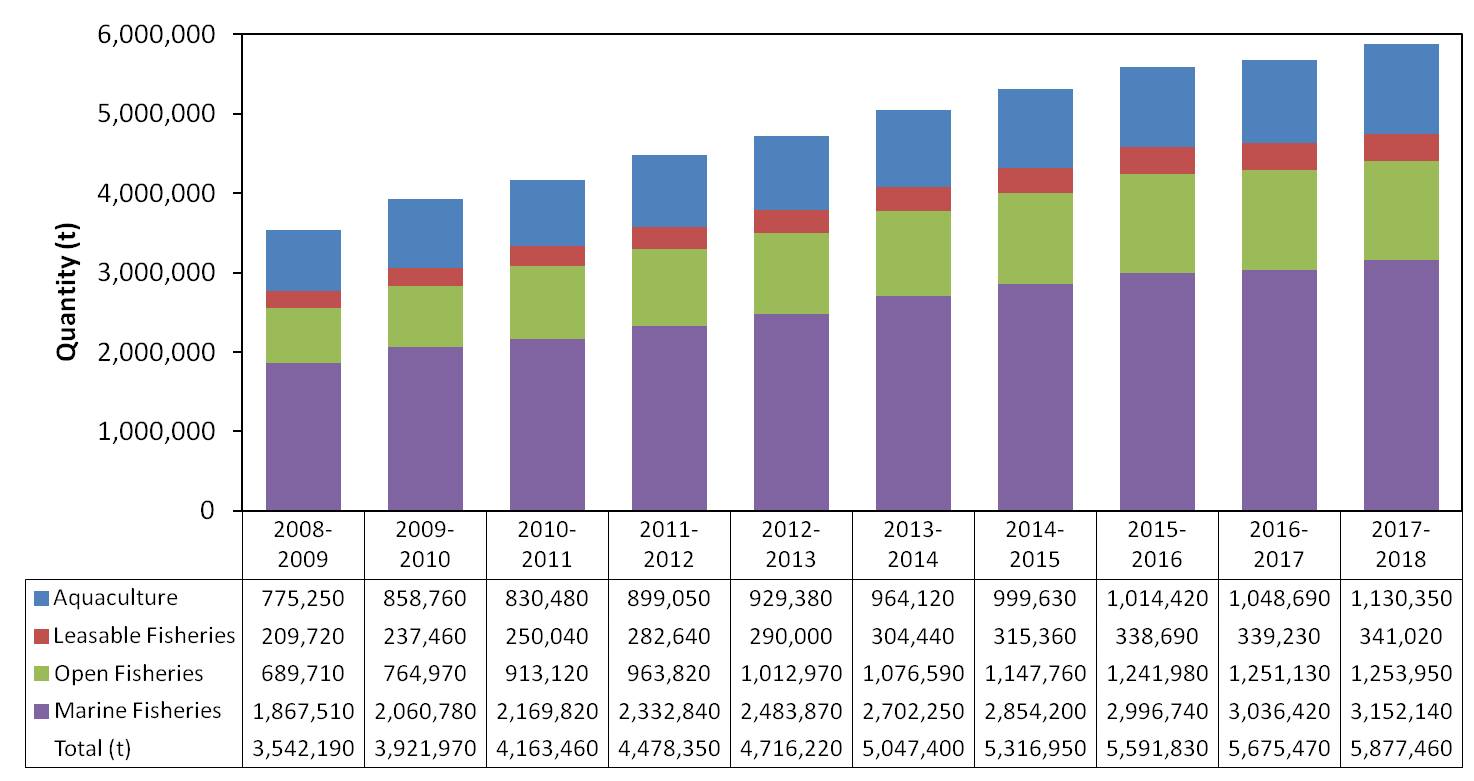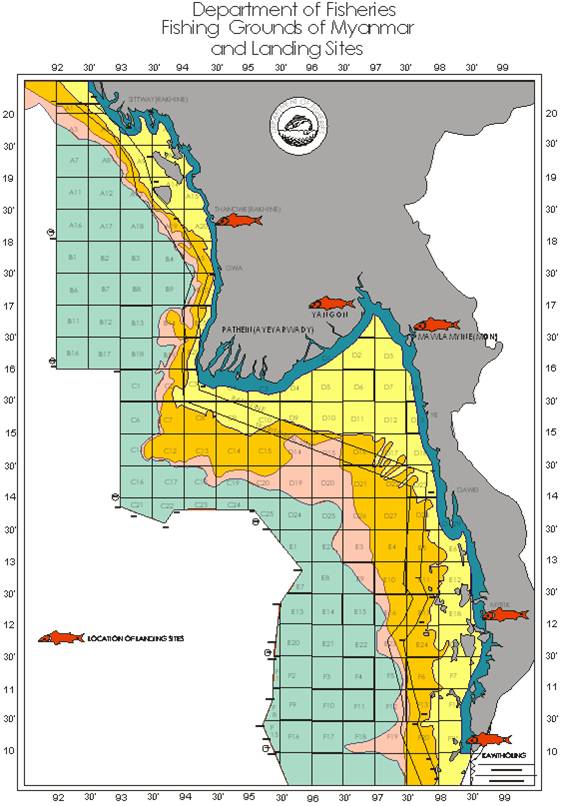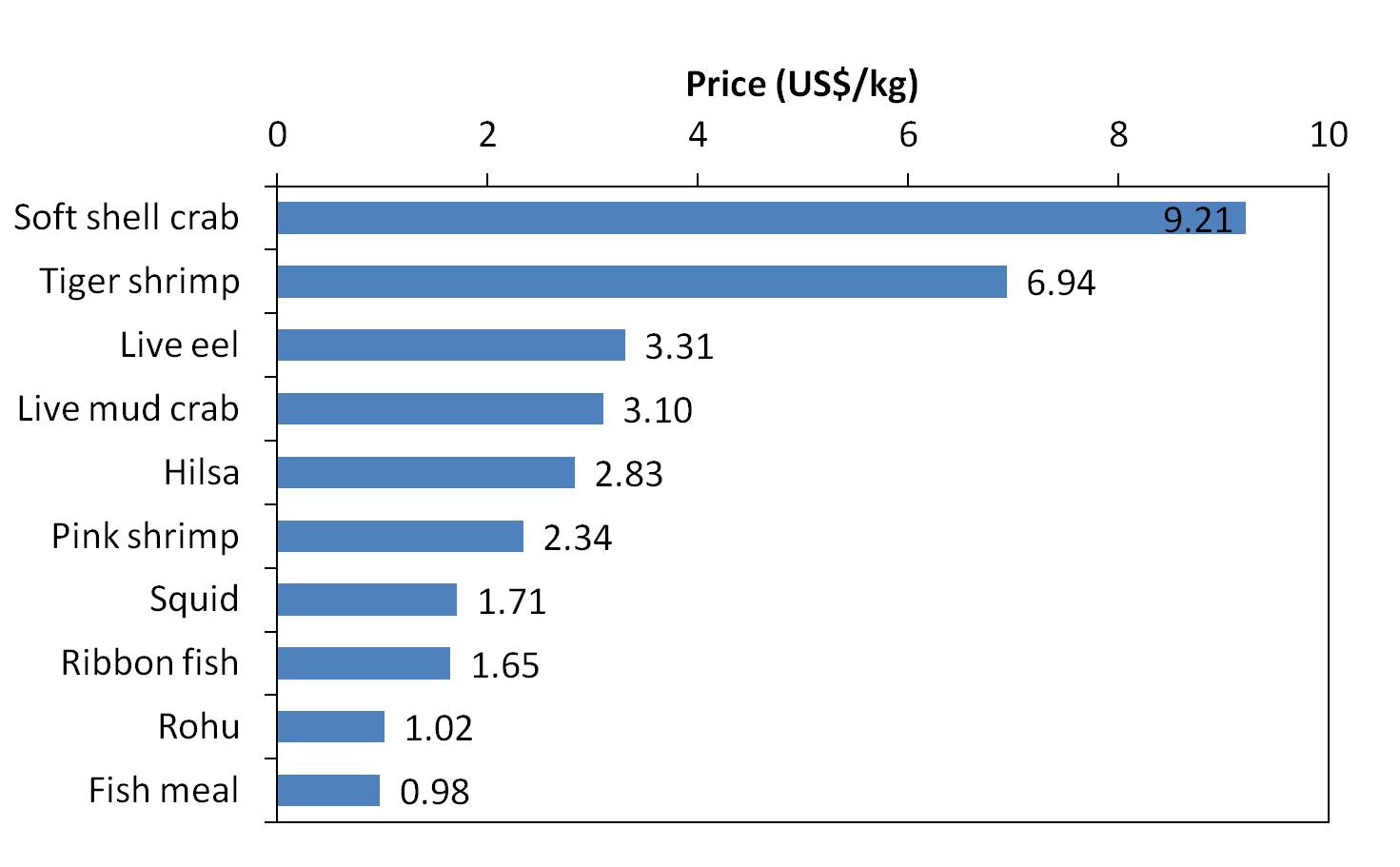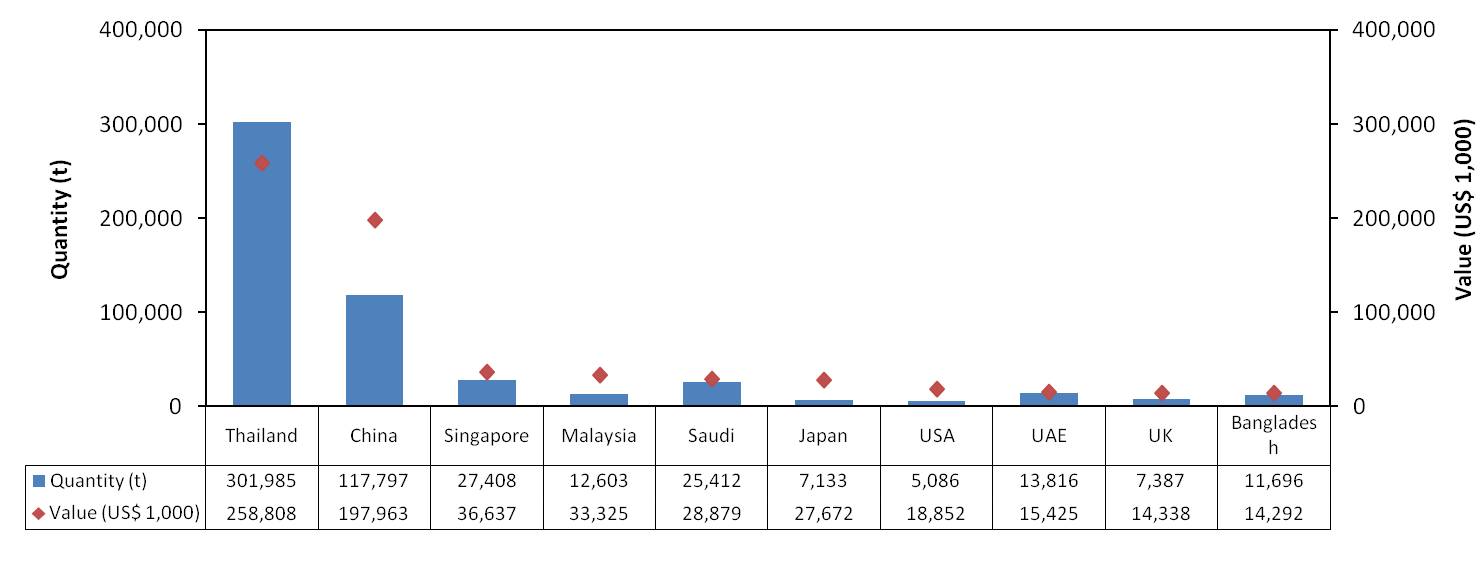By Kay Khine Tint, 2019 Regional Fisheries Policy Network (RFPN) Member for Myanmar
INTRODUCTION
The Republic of the Union of Myanmar has a total land area of 676,580 km2 and it is bordered by Bangladesh and India in the Northwest, China in the Northeast, Lao PDR in the East, and Thailand in the Southeast (Figure 1). Its exclusive economic zone (EEZ) is about 486,000 km2 and the 2,138 km coastline is along the Indian Ocean, Bay of Bengal, and Andaman Sea. The inland water bodies consist of 8.2 million ha of lakes, rivers, and reservoirs and the main rivers include Ayeyarwaddy, Chindwin, Sittatung and Thanlwin. The climate of the country is tropical monsoon and has low humidity during winter. Myanmar’s population was approximately 54 million in 2017. The country is known as the Golden Land because of many golden pagodas all over the country. The capital city is Naypyidaw while the largest city and economic center is Yangon (STIP, 2019). The official language is Myanmar and the regional local languages are Kachin, Kayah, Karen, Chin, Mon, Rakhine, and Shan.
FISHERIES SECTOR
The Department of Fisheries (DoF) is the responsible government agency for the development and management of the fisheries sector of Myanmar. In 2017, the livestock and fisheries sectors contributed 8 % the national GDP and the annual fish consumption per capita was 66 kg. The fisheries sub-sectors are aquaculture, inland fisheries, and marine fisheries.
For aquaculture, the culture environments include fresh water, brackish water, and marine. Freshwater aquaculture has a total area of about 198,840 ha and mostly located in the southern part of the country, particularly in the Yangon, Bago, and Ayeyarwady regions. Rohu (Labeo rohita) is the dominant cultured species and 75 % of the production is for export (DoF, 2018).
Inland fisheries cover leasable fisheries and open fisheries. For leasable fisheries, the fishing rights are granted under a lease by the DOF subject to stipulation relating to the area, species, fishing implement (gear), period, and fishing method. For open fisheries, fishing activities are permitted by the issue of fishing implement license or by floating tenders after specifying fishing ground, with the exception of the areas specified by DOF for leasable fisheries.
The fishing operations of marine fisheries are categorized as offshore and inshore. For the inshore fisheries, the traditional fishing boats are not more than 30 ft and less than 25 HP engine which operate within the area from shoreline to 10 nmi. For offshore fisheries, the fishing vessels are more than 30 ft long with 25 HP engine which operate from the outer limit of the inshore fishing zone to the EEZ (DoF, 2018).
For fishery statistics, the data recording follow the country’s fiscal year which commences from 1 April of the current year to 31 March of the following year. From the fiscal year 2008-2009 to 2017-2018, the total fisheries production of Myanmar was continually increasing (Figure 2). In 2017-2018, the total fisheries production was about 5.88 million t (19 % from aquaculture, 6 % from leasable fisheries, 21 % from open fisheries, and 54 % from marine fisheries).
FISHERIES TRADE
As shown in Figure 3, the fish and fishery products are transported to the fish landing sites or jetties for auction/wholesale/retails in market, and processed for export. The main jetties approved by the EU, i.e., Shwe Yaw Hein and Annawa Aung, are located in Yangon (Figure 4). For the Shwe Yaw Hein jetty, it caters more than 180 vessels and complying with good manufacturing practices (GMP) and the Hazard Analysis and Critical Control Points (HACCP), it serves as the main source of exported raw materials.
EXPORT OF FISH AND FISHERIES PRODUCTS
The quantity and value of fish and fishery products exported by Myanmar from the fiscal year 2008-2009 to 2017-2018 are shown Figure 5. The major fish and fishery products include fish, prawn, and others (crab, eel, dried prawn, and fish meal). In 2017-2018, Myanmar exported 10 % of the total fish production which was around 568,227 t with the value of about US$ 711 million. The soft shelled crab had the highest price among the exported fish and fishery products which was sold at US$ 9.21/kg (Figure 6) and Thailand was the top most country of destination (Figure 7).
MAJOR ISSUES
- Unstable price of exported Rohu species because the price is higher in the upper region than in the lower region due to higher transportation costs
- Unreliable food safety management because of weak coordination among responsible agencies in implementing the existing laws and regulations
- Inability of local fish farmers and processors to comply with the food safety requirements of other countries because of insufficient budget support for modern facilities and equipment
LAWS ON FISHERIES TRADE
- Directive 2/2015 (Technical Regulation for Export and Import Fishery Products) – consumer safety and qualification of the fishery products and compliance with the ASEAN Economic Community and the international standardization
- Directive 8/2018 (Amendment of Directive No.2/2015) – fishery establishments should practice food safety activities throughout the supply chain such as in fishing, aquaculture, fishing vessels, landing sites, auction markets, feed plants, ice plants for fishery products, and processing establishments complying with the requirements of international markets in the ASEAN Member States, China, and other countries
INTERNATIONAL TRADE AGREEMENT
Myanmar is a member and signatory of the following bilateral, multilateral, and international agreements:
- Bilateral Agreements (Sri Lanka, Bangladesh, China, South Korea, Lao PDR, Malaysia, India, Philippines, Thailand, and Viet Nam)
- Border Trade Agreements (China, India, Bangladesh, Thailand, and Lao PDR)
- Free Trade Agreements (China, Hong Kong, Japan, South Korea, India, Australia, and New Zealand)
- Trade and Investment Framework Agreement (USA)
- Investment Protection Agreement (EU)
- Multilateral Free Trade Agreements (Australia, New Zealand, China, India, Japan, and South Korea)
- Bay of Bengal Initiative for Multi-sectoral Technical and Economic Cooperation
- World Trade Organization
WAY FORWARD
In collaboration with the SEAFDEC Marine Fisheries Research Department (MFRD), DoF implemented the project “Traceability Systems for Aquaculture Products in the ASEAN Region” from 2010 to 2014, which aimed to expand fish trade and enhance competitiveness of fish and fishery products for regional and international trade. At present, Myanmar is now applying the traceability systems in the supply chain of aquaculture products. Moreover, the country’s aquaculture products can be exported nowadays to the EU because of the development of the National Residue Monitoring Plan supported by the EU. The DoF, in cooperation with EU-GIZ, has implemented the Myanmar Sustainable Aquaculture Program (MYSAP) since 2017 in order to improve the aquaculture production and income through sustainable aquaculture by applying the good aquaculture practices (GAqP). The EU continues to provide the training on GAqP for awareness raising and capacity building of DoF staff and stakeholders.
REFERENCES
DoF. (2018). Fisheries Statistic Book. Department of Fisheries- Minitstry of Agriculture, Livestock and Irrigation. Nay Pyi Taw, Myanmar
STIP. (2019). Seafood trade intelligence portal. Retrieved from https://seafood-tip.com/sourcing-intelligence/countries/myanmar/
FAO. (2006). FAO Fishery Country Profile – The Union of Myanmar. Retrieved from http://www.fao.org/fi/oldsite/FCP/en/MMR/profile.htm
ACKNOWLEDGMENTS
The author would like to express her gratitude and appreciation to the staff of Department of Fisheries, Myanmar for providing necessary data information, and to SEAFDEC Secretary-General and senior officials for providing valuable advice. Also, special thanks to Ms. Virgilia Sulit and Ms. Shiela Villamor Chumchuen for their guidance in writing this article.
ABOUT THE AUTHOR
Ms. Kay Khine Tint is a Senior Fishery Officer at the Aquaculture Division, Department of Fisheries, Ministry of Agriculture, Livestock and Irrigation with address at Building No. 36, Nay Pyi Taw, Myanmar and telephone +673418538. She can be reached at kaykhinetint@gmail.com.
 SEAFDEC Southeast Asian Fisheries Development Center
SEAFDEC Southeast Asian Fisheries Development Center
